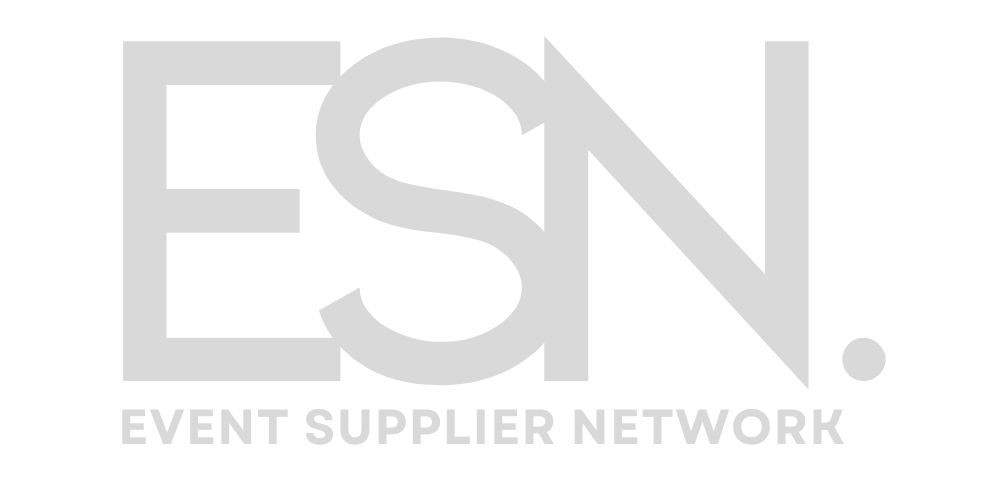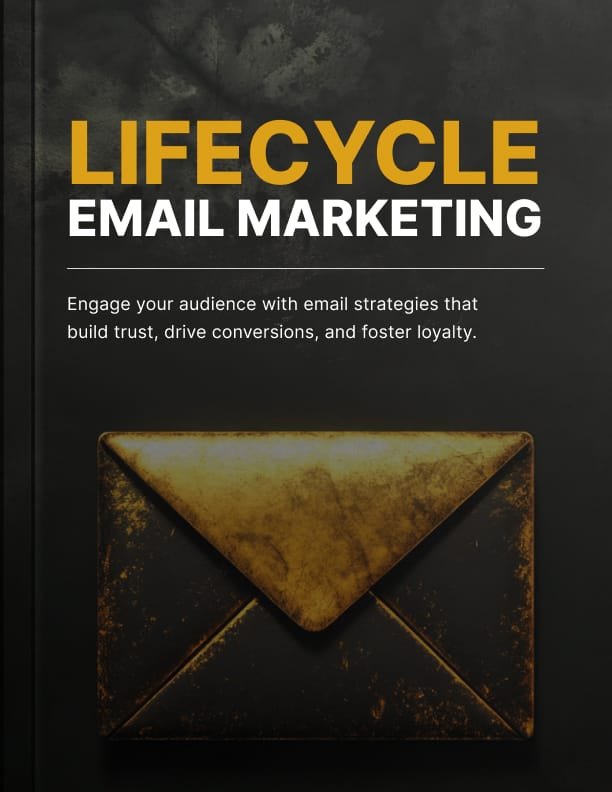INTRODUCTION
Email marketing is one of the most powerful tools you can use to grow your business and build lasting customer relationships. This course is designed to show you how to turn email into a strategic powerhouse, guiding your customers from their first interaction with your brand to becoming loyal advocates.
| It’s not about sending more emails, it’s about sending the right emails. |
In these pages, you’ll learn how to align your email strategy with every stage of the customer journey. Whether you’re building brand awareness, nurturing leads, driving conversions, or fostering loyalty, you’ll discover actionable strategies to make every email count. With clear examples and step-by-step advice, you’ll gain the skills to create campaigns that stand out and deliver real results.
This ebook will teach you how to segment your audience and craft personalized, automated emails that feel timely and relevant. You’ll learn to design campaigns that not only get opened but also inspire clicks and actions. The focus is on creating emails that add value, build trust, and strengthen connections with your audience.
You might be thinking, “I’ve tried email marketing before, and it didn’t work for me.” Or perhaps you’re already seeing some success but know there’s room for improvement. It’s not about sending more emails, it’s about sending the right emails. Wherever you’re starting from, this course will take you to the next level. We’ll challenge your assumptions, introduce you to innovative techniques, and help you see email marketing through a fresh lens.
Are you ready to stop treating email as just another task on your to-do list and start using it as the powerful strategic tool it can be? Are you prepared to leave your competitors in the dust as you forge stronger connections with your audience and drive unprecedented growth for your business? Then it’s time to dive in. This ebook isn’t just about learning, it’s about doing. Each chapter will equip you with practical strategies you can implement immediately to see real results. Now is the time to start using email as a strategic tool to grow your business. Let’s get started and explore the full potential of your email marketing.
BUILDING THE FOUNDATION FOR BRAND AWARENESS
The journey of email marketing begins with capturing attention and building a strong foundation. This chapter explores essential techniques to introduce your brand and expand your subscriber base effectively, providing you with a toolkit of strategies to kickstart your email marketing efforts.
Crafting Compelling Lead Magnets
Creating an irresistible lead magnet is crucial for attracting potential subscribers. A lead magnet is a free offer that provides value to your target audience in exchange for their contact information. To create an effective lead magnet, identify your audience’s pain points, choose a suitable format (e.g., ebook, whitepaper, checklist), create high-quality content that showcases your expertise, make it easy to consume, and design an attractive cover or landing page.
For instance, a fitness coach targeting busy professionals might offer a “5-Minute Desk Workout Guide” as a lead magnet, addressing the pain point of finding time to exercise while providing immediate value.
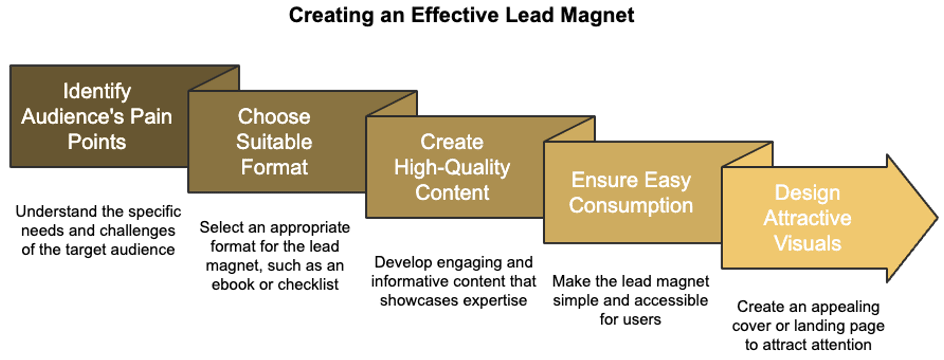
Double Opt-In and Personalized Welcomes
A double opt-in process ensures that the subscribers you’re gaining are high-quality leads. This method requires new subscribers to confirm their email address before being added to your list. While it may seem like an extra step, it offers several benefits, including ensuring valid email addresses, reducing spam complaints, and improving overall list quality. Most email marketing platforms offer this as a built-in feature, which you can easily enable and customize to match your brand voice.
Your welcome email sets the tone for your ongoing relationship with subscribers. To craft an impactful welcome email, send it immediately after subscription confirmation, personalize the greeting, deliver on your promise (e.g., providing the lead magnet), set expectations for future communications, encourage engagement, and provide immediate value.
Here’s an example of a strong welcome email:
“Hi [First Name],
Welcome to the [Your Brand] family! We’re thrilled to have you on board.
As promised, here’s your free ‘5-Minute Desk Workout Guide’ [link]. I hope you find it useful on your busy day.
You can expect to hear from us once a week with more fitness tips, nutrition advice, and motivation to keep you on track with your health goals.
Got a question? Just hit reply to this email – I’d love to hear from you!
Stay healthy,
[Your Name]”
Interactive Emails and Sign-Up Incentives
Standing out in crowded inboxes is crucial. Interactive email content can help capture and maintain attention by creating an engaging experience right in the inbox. Some interactive elements you can incorporate include countdown timers, polls and surveys, animated GIFs, accordion features, and image carousels.
For example, a clothing retailer might use an image carousel to display different outfits with a “Shop Now” button beneath each one, allowing subscribers to browse products without leaving their inbox.
Incentivizing newsletter sign-ups can significantly boost subscription rates. Effective incentives include discounts on first purchases, free shipping for e-commerce businesses, exclusive content, early access to new products or services, and entry into giveaways. Making the incentive valuable enough to motivate action while protecting your bottom line is essential.
Optimizing Forms and Growing with Social Media
Your sign-up form is the gateway to your email list, and optimizing it can dramatically increase conversion rates. Keep the form simple by asking for minimal information, place forms strategically on your website, use clear and action-oriented language, ensure mobile-friendliness, incorporate social proof, and test different designs to find what works best for your audience.
Leveraging social media can be an effective way to grow your email list. Convert your social media followers into email subscribers by promoting your lead magnet, using platform-specific features like Instagram Stories’ “Swipe Up” function, running social media contests with email sign-up as a condition of entry, adding sign-up buttons to your profiles, and sharing exclusive email content to create FOMO (fear of missing out).
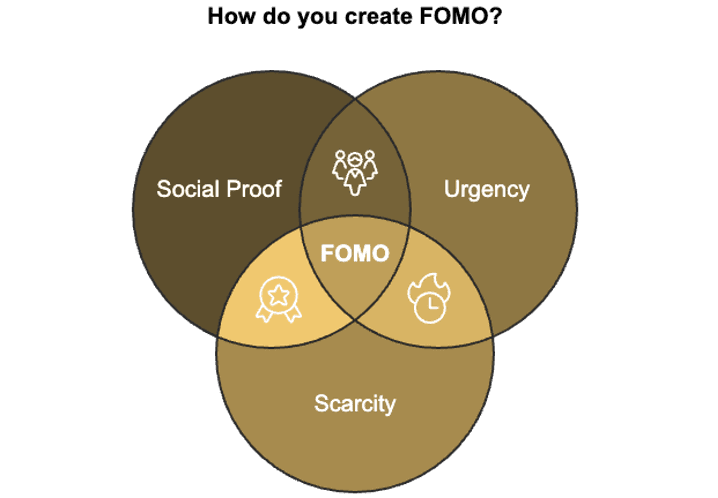
Measuring and Improving Your Efforts
To ensure the success of your email marketing strategy, it’s crucial to measure your results and continually improve. Key metrics to track include:
- Subscription Rate
- Confirmation Rate (for Double Opt-In)
- Welcome Email Open Rate
- Click-Through Rate (Ctr) on Lead Magnets
- Unsubscribe Rate
Use these metrics to identify areas for improvement and refine your approach.
Building a strong foundation for your email marketing efforts is essential for long-term success. Implementing these strategies sets the stage for an engaged and growing subscriber base. Keep in mind that successful email marketing involves providing value at every step, from the moment someone considers signing up to your list through their first interaction with your brand via email and ongoing communication. Always ask yourself: “How can I make this valuable for my subscriber?“
As you move forward, keep testing and refining your approach. What works for one brand might not work for another, so don’t be afraid to experiment. With persistence and a focus on your subscribers’ needs, you’ll build a strong, engaged email list that becomes a valuable asset for your business.
| Metric | Description | Importance |
| Subscription Rate | Percentage of visitors who subscribe to your list | High |
| Confirmation Rate | Percentage of people who confirm their subscription (for double opt-in) | Medium |
| Welcome Email Open Rate | Number of new subscribers who open your welcome email | High |
| Click-through Rate on Lead Magnets | Number of people who download or access your lead magnet | Medium |
| Unsubscribe Rate | Percentage of people who leave your list | Low |
This table provides a quick reference for the key metrics to track in your email marketing efforts, along with their relative importance. Monitoring these metrics provides valuable insights into the effectiveness of your strategies and helps you make data-driven decisions to improve your email marketing performance.
TURNING PROSPECTS INTO ENGAGED CUSTOMERS
Email marketing isn’t just about building a list; it’s about cultivating relationships. This chapter dives into the art of nurturing leads, transforming curious prospects into loyal, engaged customers through strategic email campaigns.
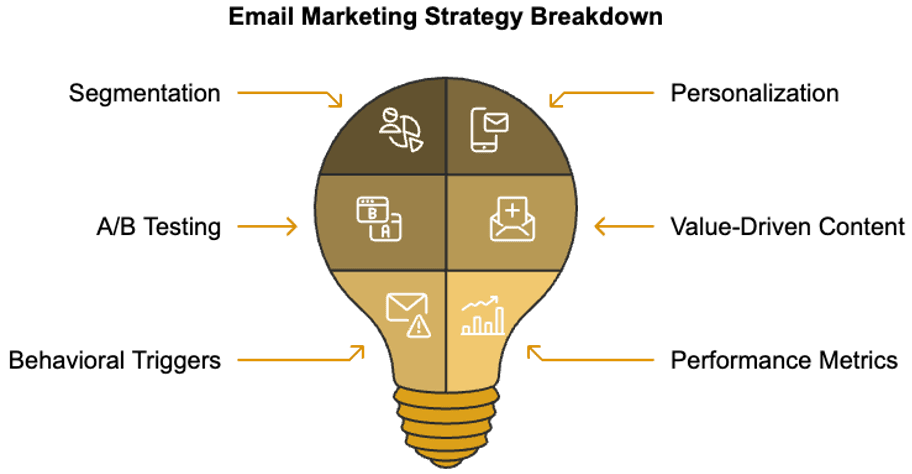
The Power of Segmentation
Segmentation allows you to tailor your messages to specific groups within your audience, increasing relevance and engagement. Dividing your list based on various criteria allows you to deliver content that resonates with each segment’s unique needs and interests. To start segmenting your list effectively, analyze your existing data, create buyer personas, use behavioral data, and implement progressive profiling. For example, an online bookstore might segment its list by genre preferences, reading frequency, and purchase history. This allows for highly targeted recommendations and promotions that speak directly to each reader’s interests.
Crafting Personalized Email Sequences
Once you’ve segmented your list, it’s time to create email sequences that guide your leads through the consideration phase. Automated email sequences, also known as drip campaigns, allow you to nurture leads at scale while maintaining a personal touch. To create effective email sequences, map out the customer journey, set clear goals for each email, write compelling subject lines, provide value in every email, and include clear calls-to-action (CTAs). Refining and expanding your email marketing efforts requires keeping ethical considerations at the forefront.
Leveraging A/B Testing for Optimization
To maximize the impact of your nurturing efforts, you need to continually refine your approach. A/B testing, also known as split testing, allows you to compare different versions of your emails to see which performs better. Elements you can A/B test include subject lines, email copy, CTAs, images, send times, and sender names. When conducting A/B tests, test one element at a time for clear results, use a large enough sample size for statistical significance, run the test for an appropriate duration, and analyze results and implement winning variations.
Building Trust Through Value-Driven Content
As you nurture your leads, focus on providing genuine value rather than constantly pushing for a sale. Positioning your brand as a trusted advisor helps you build stronger relationships that naturally lead to conversions. Ways to provide value through email include educational content, exclusive offers, personalized recommendations, user-generated content, and behind-the-scenes content. For example, a skincare brand might send a series of emails educating subscribers about different skin types, common concerns, and ingredient benefits. This positions the brand as an expert in the field, building trust and encouraging subscribers to turn to their products when ready to make a purchase.
Behavioral triggers allow you to send timely, relevant emails based on specific actions (or inactions) taken by your subscribers. These automated emails can significantly boost engagement and conversions by reaching out to leads at crucial moments in their customer journey. Common behavioral triggers include abandoned cart reminders, product view follow-ups, inactivity re-engagement, purchase thank-yous, and content download follow-ups. For instance, if a subscriber views a product on your website but doesn’t make a purchase, you could trigger an email sequence that provides more information about the product, answers common questions, and perhaps offers a limited-time discount to encourage the purchase.
To ensure your nurturing efforts are effective, you need to track key metrics and continuously improve your strategy. Some important metrics to monitor include open rates, click-through rates, conversion rates, unsubscribe rates, and revenue per email. Use these metrics to identify areas for improvement and test new approaches. For example, if you notice a high open rate but low click-through rate, you might need to work on making your email content more engaging or your CTAs more compelling.
Let’s look at how a hypothetical SaaS company, CloudTech, improved its lead nurturing process:
- Challenge:
Struggling to convert free trial users into paying customers
- Solution:
Implemented a targeted nurture sequence for trial users, focusing on educating them about key features and providing personalized support
- Results:
25% increase in trial-to-paid conversion rate, 30% higher engagement with product features, 15% reduction in customer support inquiries
This case study demonstrates the power of a well-crafted nurture sequence in guiding leads towards conversion.
Implementing your lead nurturing strategy may present some challenges. Common issues include low engagement rates, high unsubscribe rates, difficulty in measuring ROI, content creation bottlenecks, and lack of personalization. To address these challenges, revisit your segmentation strategy, review your email frequency and content strategy, implement proper tracking and attribution models, develop a content calendar, and invest in tools that allow for dynamic content insertion based on subscriber data.
Once you are comfortable with basic nurturing strategies, consider using advanced techniques such as predictive lead scoring, multi-channel nurturing, interactive content, hyper-personalization, and account-based marketing (ABM) for B2B companies. Implementing these strategies and refining your approach will turn your email list into a powerful tool for building lasting customer relationships. Effective lead nurturing is about providing value, building trust, and guiding prospects towards a decision that benefits both them and your business. Stay focused on your subscribers’ needs, and you’ll see your efforts rewarded with higher engagement, increased conversions, and loyal customers who advocate for your brand. The journey from prospect to engaged customer is a delicate process, but with the right nurturing strategies, you can create a seamless path that not only converts leads but also fosters long-term relationships built on trust and mutual value.
STRATEGIC CAMPAIGNS FOR CONVERSIONS
The art of converting leads into customers is at the heart of successful email marketing. This chapter equips you with powerful strategies to design email campaigns that drive conversions and accelerate customer acquisition.
Crafting Irresistible Promotions
To capture your audience’s attention and prompt action, you need to create promotions that resonate with their needs and desires. Start by understanding your target audience’s pain points and motivations. What problems do they need to solve? What aspirations do they have? Use this insight to craft promotions that offer genuine value.
When designing your promotional offers, consider these five elements:
- Clear Value Proposition
- Unique Selling Point (USP)
- Compelling Visuals
- Strong Call-to-Action (CTA)
- Sense of Urgency
Clearly communicate the benefits of your offer and how it will improve your customer’s life or business. Highlight your unique advantages that make your offer stand out from competitors. Use high-quality images or videos that showcase your product or service in action. Employ action-oriented language that encourages immediate response, such as “Claim Your Discount Now” or “Start Your Free Trial Today.” Create a reason for customers to act quickly, like limited-time offers or limited stock.
The most effective promotions align with your brand values and customer expectations. A luxury brand, for instance, might focus on exclusivity rather than deep discounts, while a budget-friendly brand could emphasize value for money. Carefully considering these elements allows you to create promotions that capture attention and drive meaningful conversions.
Leveraging Scarcity and Urgency Tactics
Scarcity and urgency are powerful psychological triggers that can prompt quick action from your subscribers. When implemented ethically and honestly, these tactics can significantly boost your conversion rates. Some effective ways to incorporate scarcity and urgency into your email campaigns include limited-time offers, countdown timers, limited quantity notifications, exclusive access, and seasonal promotions.
Set clear deadlines for your promotions, such as “24-Hour Flash Sale” or “Offer Ends Sunday at Midnight.” Include dynamic countdown timers in your emails to create a visual sense of urgency. Highlight the limited availability of your product if applicable, using phrases like “Only 50 spots left” or “95% Sold Out.” Offer early or exclusive access to new products or services for a limited time. Tie your offers to specific seasons or holidays to create natural urgency.
While these tactics can be effective, it’s crucial to use them honestly. False scarcity or continual “last chance” offers can erode trust and damage your brand reputation. Always ensure that your scarcity and urgency claims are genuine and backed by real limitations or deadlines. This approach not only drives conversions but also builds long-term trust with your audience.
Cross-Selling and Up-Selling Through Email
Cross-selling and up-selling are valuable techniques for increasing the average order value and lifetime customer value. When done right, these strategies can also enhance customer satisfaction by introducing them to complementary products or premium options that better meet their needs. To effectively cross-sell and up-sell through email, analyze purchase history, segment your list, highlight benefits, use social proof, and time your communications right.
Use data on past purchases to recommend relevant additional or upgraded products. Target customers based on their buying behavior, preferences, and engagement level. Clearly explain how the additional or premium product will add value to the customer’s life or enhance their original purchase. Include customer reviews or testimonials to build trust in your recommendations. Send cross-sell or up-sell emails at appropriate times, such as immediately after a purchase or when a customer has been using a product for a while.
Here’s an example of how an e-commerce clothing store might structure an up-sell email:
Subject: Elevate Your Style: Premium Accessories to Match Your New Outfit
Hi [Customer Name],
Thanks for your recent purchase of [Product Name]. We hope you love it as much as we do!
To complete your look, we’ve handpicked some premium accessories that pair perfectly with your new outfit:
[Product Image 1]
[Product Name] – $XX
“This takes my outfit from day to night effortlessly!” – Sarah K., Verified Buyer
[Product Image 2]
[Product Name] – $XX
“The quality is exceptional. Worth every penny!” – Mark T., Verified Buyer
As a valued customer, enjoy 15% off these accessories for the next 48 hours.
[Shop Now Button]
Happy styling!
[Your Name]
Sophisticated Retargeting Strategies
Retargeting allows you to re-engage potential customers who have shown interest in your products or services but haven’t yet made a purchase. Email retargeting can be particularly effective because you’re reaching out to people who have already given you permission to contact them. Advanced retargeting strategies to implement include abandoned cart recovery, browse abandonment campaigns, post-purchase campaigns, re-engagement campaigns, and behavioral triggers.
Send a series of emails to remind customers about items left in their cart, starting with a gentle reminder, then offering assistance, and finally considering providing an incentive to complete the purchase. If a subscriber has viewed specific products on your website without purchasing, send targeted emails showcasing those items or similar products. After a customer makes a purchase, send a series of emails to ensure they’re satisfied with their purchase and to recommend complementary products. For subscribers who haven’t opened your emails or made a purchase in a while, create a campaign to win them back, which could include a special offer or simply asking for feedback on why they’ve disengaged. Set up automated emails based on specific actions (or inactions) taken by subscribers on your website or in previous emails.
The key to effective retargeting is relevance and timing. Your emails should feel helpful and personalized, not intrusive or pushy. By tailoring your retargeting efforts to the specific behaviors and interests of your subscribers, you can create more engaging and effective campaigns that drive conversions and build customer loyalty.
Monitoring Campaign Metrics for Real-Time Optimization
To ensure your promotional campaigns are delivering results, it’s crucial to monitor key metrics and be prepared to adapt your strategy in real-time. Essential metrics to track include open rate, click-through rate (CTR), conversion rate, revenue per email (RPE), unsubscribe rate, and bounce rate. These metrics provide valuable insights into the performance of your campaigns and can guide your optimization efforts.
Open rate indicates how many recipients opened your email, while CTR shows how many people clicked on links within your email. Conversion rate is arguably the most important metric as it directly relates to your campaign’s success, showing the percentage of email recipients who completed the desired action. RPE helps you understand the monetary value of each email sent. While some unsubscribes are normal, a spike in this rate might indicate your email frequency is too high or your content isn’t relevant to your audience. A high bounce rate could indicate issues with your email list quality or deliverability problems.
To optimize your campaigns in real-time, use A/B testing to test different elements of your emails, implement dynamic content to personalize email content in real-time, adjust send times based on when your emails get the best engagement, refine segmentation by continuously updating your subscriber segments based on behavior and engagement data, and monitor customer feedback by paying attention to direct replies to your emails and customer service inquiries related to your campaigns.
| Metric | Description | Optimization Strategy |
| Open Rate | Percentage of recipients who opened the email | Improve subject lines and sender name |
| Click-Through Rate (CTR) | Percentage of recipients who clicked on email links | Enhance content relevance and CTA design |
| Conversion Rate | Percentage of recipients who completed desired action | Refine offer and landing page experience |
| Revenue Per Email (RPE) | Average revenue generated per email sent | Improve targeting and offer value |
| Unsubscribe Rate | Percentage of recipients who unsubscribed | Adjust email frequency and content relevance |
| Bounce Rate | Percentage of emails that couldn’t be delivered | Clean email list and improve deliverability |
Consistently monitoring these metrics and implementing real-time optimizations allows you to continuously improve the performance of your email campaigns and achieve better results over time.
EFFECTIVE FOLLOW-UPS FOR LOYALTY
Success in business isn’t just about acquiring new customers, it’s about keeping them. This chapter explores how you can use email marketing to transform one-time buyers into loyal advocates for your brand. You’ll discover strategies for crafting compelling post-purchase communications, developing effective loyalty programs, and creating engaging content that adds ongoing value to your customers’ lives.
The Power of Post-Purchase Engagement
Your relationship with a customer doesn’t end at the point of sale. In fact, that’s where the real work begins.
Post-purchase engagement is crucial for building long-term customer relationships and encouraging repeat business. A well-crafted thank-you email can set the tone for your ongoing relationship with a customer. These emails should be more than just transactional confirmations, they’re opportunities to make your customers feel valued and appreciated. Send promptly, personalize, show genuine appreciation, reinforce their decision, provide next steps, and offer support.
Following up after the sale shows customers that you care about their experience beyond the transaction. These check-ins can provide valuable feedback and opportunities to address any issues promptly. Send your first check-in email about a week after the product is delivered or the service is rendered. Ask for feedback, provide resources, address potential issues, and invite questions. Implementing these strategies will create a positive post-purchase experience that encourages customer loyalty and repeat business.
Developing Effective Loyalty Programs
Loyalty programs can be powerful tools for encouraging repeat business and fostering a sense of belonging among your customers. When integrated seamlessly with your email marketing efforts, these programs can significantly boost customer retention.
Here are some key considerations for developing an effective loyalty program:
- Make it easy to understand
- Offer valuable rewards
- Personalize
- Consider tiered systems
- Surprise and delight
- Maintain regular communication
Implementing these strategies will help you create a loyalty program that rewards customers while keeping them engaged and excited about your brand. The goal is to make customers feel valued and appreciated, encouraging them to choose your brand over competitors repeatedly.
Creating Educational Content for Ongoing Value
Providing educational content that adds value to your customers’ lives is a powerful way to maintain engagement and foster loyalty. This content can take many forms, including how-to guides, product usage tips, industry insights, or lifestyle content related to your products. Understand your audience, solve problems, use various formats, keep it relevant, be consistent, and encourage interaction.
Here’s an example of how you might structure an educational content series:
| Week | Topic | Content Type |
| 1 | Hidden features you might be missing | Video tutorial |
| 2 | Troubleshooting common issues | Infographic |
| 3 | Creative ways to use your product | UGC showcase |
| 4 | Maintenance tips for longevity | Step-by-step guide |
Providing valuable, educational content on a regular basis positions your brand as a helpful resource rather than just a product or service provider. This approach builds trust, enhances customer satisfaction, and ultimately contributes to long-term loyalty.
Winning Back Dormant Customers
Even with the best retention strategies, some customers will inevitably become inactive over time. Re-engagement campaigns, often called “win-back” campaigns, are designed to reignite interest among these dormant customers. Segment your list, personalize your approach, offer an incentive, show what they’re missing, ask for feedback, and create a sense of urgency.
When crafting your re-engagement emails, it’s important to strike the right tone. You want to remind customers of the value you offer without being pushy or making them feel guilty for their absence.
Here’s a simple formula you might use:
Re-engagement email = Friendly greeting + Acknowledgment of absence + What’s new + Special offer + Call to action
This formula helps ensure you cover all the key elements of an effective re-engagement campaign while maintaining a positive, welcoming tone.
Keeping Communication Fresh and Relevant
To maintain customer engagement over the long term, it’s crucial to keep your email communications fresh and relevant. Regularly update your email templates, experiment with different content types, use dynamic content, stay on top of trends, celebrate milestones, create seasonal campaigns, and ask for preferences.
Effective email marketing relies on providing consistent value to your subscribers. Implementing strategies for post-purchase engagement, loyalty programs, educational content, re-engagement, and keeping your communications fresh will help turn one-time buyers into loyal brand advocates.
Implementing these strategies requires keeping your focus on the customer. What value are you providing? How are you making their lives easier or better? Consistently delivering value to your leads and maintaining open communication helps you build strong, lasting relationships with your customers that drive long-term business success.
One effective way to ensure you’re consistently providing value is to create a content calendar that balances different types of emails. Here’s an example of how you might structure your monthly email content:
| Week | Email Type | Purpose |
| 1 | Product highlight | Showcase new or popular items |
| 2 | Educational content | Provide valuable tips or insights |
| 3 | Customer spotlight | Share success stories or testimonials |
| 4 | Exclusive offer | Reward loyalty with special promotions |
This approach ensures a mix of promotional and value-added content, keeping your communications interesting and engaging for your subscribers. Remember, the goal is not just to sell, but to build a relationship with your customers that extends beyond the transaction. By providing consistent value, you’ll create a loyal customer base that not only continues to purchase from you but also becomes advocates for your brand, recommending you to others and helping to grow your business organically.
RECAPPING EMAIL MARKETING MASTERY
The Email Marketing Ecosystem
Email marketing isn’t a series of isolated tactics; it’s an interconnected ecosystem where each element supports and enhances the others. Your efforts in building brand awareness lay the foundation for lead nurturing, which in turn sets the stage for conversions and ultimately customer loyalty. Viewing your email marketing strategy holistically allows you to create a seamless experience for your subscribers, guiding them naturally through the customer lifecycle.
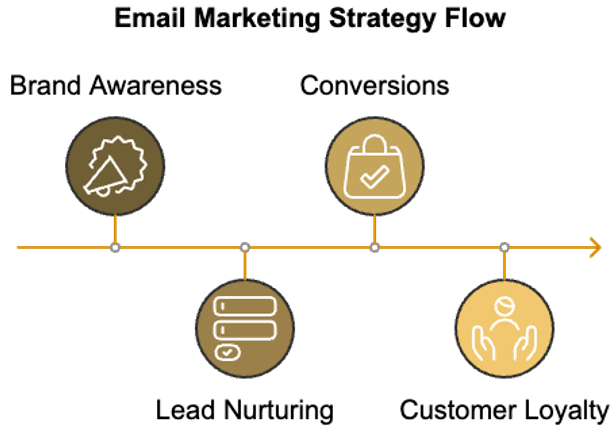
Consider how each stage of your email marketing strategy feeds into the next:
- Brand Awareness
Brand awareness sets the tone for all future interactions. The quality of your lead magnets and the effectiveness of your welcome emails directly impact how receptive subscribers will be to your nurturing efforts.
- Lead Nurturing
Lead nurturing directly influences your conversion rates. Providing value and establishing trust prepares subscribers to be more receptive to your promotional campaigns.
- Conversions
Conversions affect your ability to cultivate loyalty.
A positive purchasing experience sets the stage for long-term customer relationships.
- Customer Loyalty
Customer loyalty not only provides repeat business but also feeds back into your brand awareness efforts through word-of-mouth marketing and testimonials.
Understanding these connections helps you create a more cohesive and effective email marketing strategy. Each email you send should serve a specific purpose within this larger ecosystem, moving subscribers along their journey with your brand.
Aligning Email Strategies with Lifecycle Stages
To maximize the impact of your email marketing efforts, it’s crucial to align your strategies with each stage of the customer lifecycle. This alignment ensures that you’re delivering the right message to the right person at the right time, increasing the relevance and effectiveness of your communications.
Here’s how you might align your email strategies with different lifecycle stages:
| Lifecycle Stage | Email Strategy | Key Metrics |
| Awareness | Welcome series, educational content | Open rates, click-through rates |
| Consideration | Product spotlights, case studies | Engagement rates, website visits |
| Decision | Promotional campaigns, abandoned cart reminders | Conversion rates, revenue per email |
| Retention | Post-purchase follow-ups, loyalty programs | Repeat purchase rate, customer lifetime value |
| Advocacy | Referral programs, user-generated content campaigns | Referral rates, social shares |
Tailoring your email content and strategies to each lifecycle stage creates a more personalized and effective experience for your subscribers. This approach not only improves your immediate results but also builds stronger, more lasting relationships with your customers.
Experimenting and Innovating
Email marketing is always changing, with new technologies, shifting consumer preferences, and shifting market dynamics. To stay ahead of the curve and maintain the effectiveness of your email marketing efforts, you must embrace a culture of continuous experimentation and innovation. Here are some areas where you can focus your experimentation efforts:
- Content Formats
- Personalization Techniques
- Send Times and Frequencies
- Subject Lines and Preview Text
- Email Design
- Segmentation Criteria
Experimentation is not just about trying new things but about learning and improving. Carefully track your results and use the insights to refine your strategies over time.
Email marketing is changing, and new tools are being created to help improve your efforts. Using these tools lets you create more advanced, personalized, and effective email campaigns. Some key technologies to consider include Artificial Intelligence (AI) and Machine Learning, Marketing Automation, Interactive Email Elements, Predictive Analytics, and Advanced Personalization Engines. While these technologies can be powerful, it’s important to remember that they’re tools, not solutions in themselves. Using technology to support your overall strategy enhances your ability to deliver value to your subscribers and achieve your business goals.
Measuring Long-Term Success
While it’s important to track immediate metrics like open rates and click-through rates, true email marketing mastery is about driving long-term business success. To measure the lasting impact of your email marketing efforts, you need to look at broader, more holistic metrics. Some key metrics to consider for long-term success include Customer Lifetime Value (CLV), Retention Rate, Net Promoter Score (NPS), Brand Equity, and Market Share.Focusing on these longer-term metrics helps you better understand the true impact of your email marketing efforts and make strategic decisions that drive sustainable business growth.
Refining and expanding your email marketing efforts requires keeping ethical considerations at the forefront. Building lasting customer relationships requires trust, and that trust can be quickly eroded by unethical practices. Key ethical considerations in email marketing include Transparency, Permission, Privacy, Honesty, and Respect. Maintaining high ethical standards helps you comply with legal requirements and build trust with your subscribers, leading to stronger, more valuable relationships over time.
Final Thoughts
Looking ahead, it’s clear that email marketing will continue to play a crucial role in business communication and customer relationships. Email marketing mastery is not a destination, but a journey. It requires continuous learning, experimentation, and adaptation. Focusing on creating value for your subscribers, aligning strategies with the customer lifecycle, leveraging new technologies, and maintaining high ethical standards helps you create email marketing campaigns that drive immediate results while building lasting customer relationships and sustainable business growth.
At its core, email marketing is about communication and relationship-building. Always keep your subscribers’ needs and preferences at the forefront of your strategy. By doing so, you’ll create email campaigns that your subscribers look forward to receiving, engage with enthusiastically, and act upon consistently.
As you move forward, continue to refine your skills, stay curious about new developments in the field, and most importantly, never stop seeking ways to provide more value to your subscribers. Your commitment to excellence in email marketing will pay dividends in the form of loyal customers, strong brand equity, and sustained business success.
